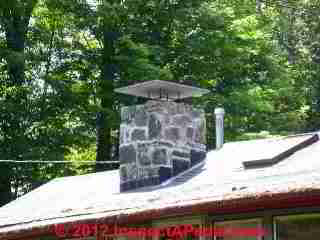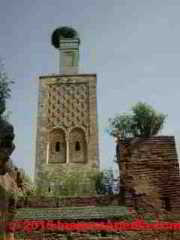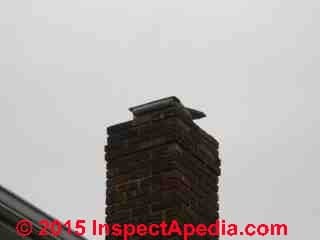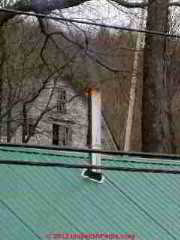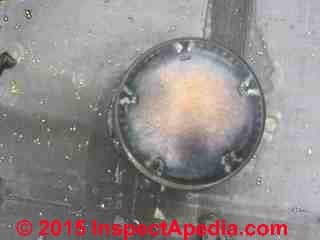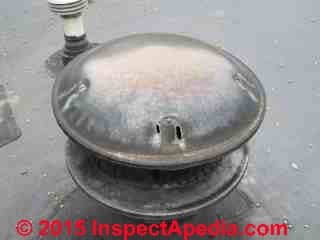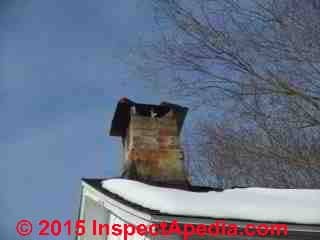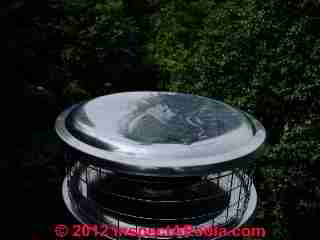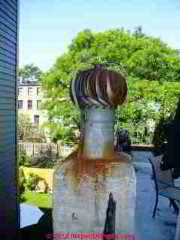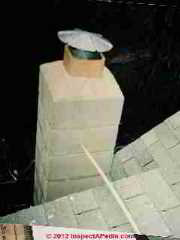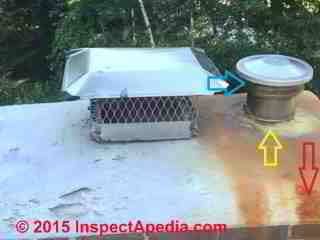 Chimney Rain Cap Inspection
Chimney Rain Cap Inspection
Chimney rain cap or top cover inspection, defects & repairs
- POST a QUESTION or COMMENT about types of chimney rain caps & chimney caps or rain caps & their inspection, installation, troubleshooting & repair or replacement.
Chimney caps & crown inspection procedures:
This article describes the inspection of and common defects or hazards found at covers & terminations found at the top of chimneys and flues. We provide a checklist of chimney top or chimney rain cap defects for building owners, contractors, or inspectors.
This article series describes chimney cap & crown types, choices, & defects, and we cite pertinent chimney top cap / crown building codes & standards for fire and other safety concerns.
InspectAPedia tolerates no conflicts of interest. We have no relationship with advertisers, products, or services discussed at this website.
- Daniel Friedman, Publisher/Editor/Author - See WHO ARE WE?
Chimney Rain Cap Inspection & Defects Checklist
At above left is a typical metal rain cap atop a masonry flue; rain caps are also found atop metal chimneys and flues. At above right is a flat stone rain cap over a stone masonry chimney.
[Click to enlarge any image]
Definition of Chimney Rain Cap or Rain Cover
A chimney rain cap is a rain cover on top of a chimney flue designed to keep out rain (which can damage the flue or appliances it vents) and intended to reduce downdrafts in the chimney in windy conditions.
Some chimney rain caps may be supported atop a masonry chimney in a position to shelter the chimney flue, and may not only cover the chimney flue opening but may also project out beyond the entire chimney top (red arrow, photo at left).
This example is still a chimney rain cap.
On many clay flue tile lined chimneys the rain cap will mount directly on to and will cover only the chimney flue itself (photo at above left).
If you are concerned about the cap or crown seal around the chimney flue where it projects through the chimney top of a (usually) masonry chimney and don't care about the rain caps shown above, see this
article CHIMNEY "CAP" CROWN / TOP SEAL INSPECTION.
Chimney Rain Cap / Rain Cover Inspection Guide to Defects
The Chimney Rain Cap or Rain Cover Has A Different Job From the Chimney Cap/Crown
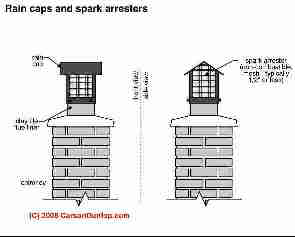
The chimney rain rain cap has the job of keeping rain and wind down-drafts out of the chimney.
Some rain caps also include a screen that functions as a spark arrestor to reduce the chances of a spark exiting the flue to land on and set afire a nearby roof surface or other materials.
The rain cap or hood shown in the sketch at left is charged with preventing sparks from leaving the chimney - a fire safety measure.
Sketch courtesy Carson Dunlop Associates.
Below we list chimney rain cap or rain cover inspection points and common defects and hazards.
The purpose of the chimney cap/crown [chimney crown] described
at CHIMNEY CROWN TOP SEAL DEFINITION is to close off the space between the flue liner and chimney wall, to shed water clear of the chimney and generally prevent moisture entry.
Blocked Chimney Flue at Chimney Top: Squashed Cap or Animal Nests
At above left, the chimney top is completely obstructed by a stork's nest. This chimney, located in Rabat, Morocco, was not in use when we took the photo.
Mechanical damage, birds or squirrels can all render a chimney inoperative and unsafe. The immediate hazards include fatal carbon monoxide poisoning or a building or chimney fire, while more subtle hazards from a partly-blocked chimney include improper heater operation.
A squashed chimney rain cap can also block the flue - see the photo of the round rain cap and flue at above right.
See CHIMNEY RAIN CAP OPENING SIZE for an example of the trouble caused by a rain cover that does not provide adequate flue vent opening area.
Other examples of chimneys blocked by the rain cap or spark arrestor
A retrofit chimney rain cap is shown in our photo at above left. This rain cap is designed to fit over the top of a standard sized clay chimney flue tile and is held in place by four threaded bolts that press against the sides of the flue tile. Other chimney rain caps for clay tile flues mount by friction by insertion into the interior of the top of the flue tile.
Watch out: when installed over a flue used to vent a wood-fired burning appliance such as a wood stove or a wood-burning fireplace, creosote can condense on and quickly block the mesh of the spark arrestor, leading to a blocked flue or a chimney fire.
Watch out: over tightening the securing bolts of this chimney rain cap can break the flue tile, while leaving them too lose risks that the whole rain cap assembly blows away during high winds.
Deliberately or Accidentally Sealed-off Chimney Tops & Flues
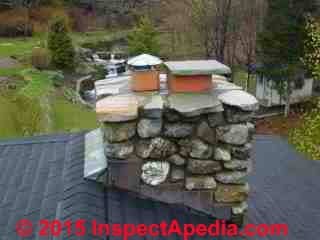
As we illustrate in our photo at above left, there are two concerns at this stone-faced masonry chimney.
- The smaller chimney flue,
typically venting heating equipment, has received a retrofit rain cap that may not permit adequate draft - note that the cap top is quite close to the top of the clay chimney flue tile upper surface. - The larger chimney flue,
probably venting a fireplace, has been closed or capped-over using a single solid piece of stone or slate. Why would someone do this? Some common explanations for this chimney top seal include:
- The fireplace damper has been rusted away, damaged or lost and the owner wanted to stop winter heat loss through the flue.
- The fireplace is not in use and the owner wanted to keep animals and/or rain out of the chimney flue
Watch out: we often find a temporarily capped-off fireplace flue or unused chimney flue that was left in that condition by a prior building owner. The new owner, attempting to use the chimney before its safety and condition have been determined, faces risk of being driven out of the home by smoke at a fireplace or worse, potentially fatal carbon monoxide poisoning if the flue is to be used by a heating appliance.
Watch out: for flat stones, slate, or other covers that may have been placed atop a chimney that was thought to be out of use (photo, above left [Click to enlarge any image]).
We've encountered cases of a homeowner returning to service a fireplace or chimney flue whose top was covered over completely as our photo depicts. The result is potentially fatal carbon monoxide poisoning or a fireplace that causes smoke damage in the building.
Also see MASONRY CHIMNEY TOP DAMAGE.
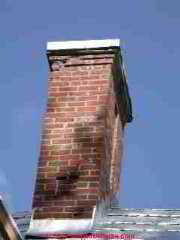
Above we illustrate more "sealed-off" masonry chimneys.
Be,kw located atop the Justin Morrill Smith historic home in Strafford Vermont, this brick masonry chimney has been capped off with a metal cover.
The chimney is no longer in use and preservationists wanted to protect the chimney interior and exterior from leaks and from further frost damage. At the chimney's left corner as well as in smaller areas below you can see evidence of severe frost related spalling of its brick surfaces. Also
see CHIMNEY SPALLING
At above-right someone has placed solid slate atop a presumably unused brick chimney.
Lost or Missing Chimney Rain Cap
The most common defect we observe at chimney rain caps is that there is none - the rain cap was never installed, or it has been lost or blown away. Below, photographs of two types of factory built metal chimneys illustrate the loss of the chimney's rain cap. Below you can also notice water ponding around the chimney flue.
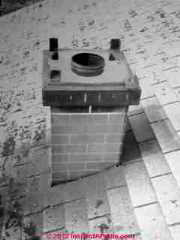
If we want proof that people don't spend a lot of time looking at their chimney, ask a home inspector or chimney sweep how often they find that the rain cap or spark arresting chimney cap has been completely lost from a chimney. At above right we see leak stains from water that has been running down the interior of this heating appliance chimney flue.
As our photographs illustrate, a missing cap invites water damage to the chimney and the equipment it vents, draft problems (no protection against downdrafts caused by some wind conditions), and unsafe operation.
Water entering the chimney can cause enough corrosion in a metal flue that the chimney needs replacement.
Water entering the chimney also risks corroded leaky flue vent connectors, leading to draft problems and carbon monoxide poisoning risks as well as costly or dangerous damage to the heating equipment itself.
The stainless steel chimney cap shown in the two photos above sports a more subtle hazard.
Corrosion at the welds that connect the round chimney cap to the metal brackets that in turn connect the chimney cap to its mounting base has caused the welds to fail. Only one of 10 welds remained in place when I inspected this chimney; one good gust of wind was sufficient to blow the cap off of this flue, risking subsequent water damage to the chimney itself or to the oil fired heating boiler connected to this chimney.
Particularly because this chimney was installed through a flat roof and was not close to the roof edge, you'd not find this hazard without an on-roof direct inspection.
Damaged or Defective Metal Rain Caps on Chimneys
Leaks at a home made chimney rain cap and at a bent, damaged factory-built chimney rain cap
The home made metal chimney cover on a brick flue (above left) has rusted through risking water damage to the chimney, flue liner, or to appliances being vented through this flue.
[Click to enlarge any image]
The concave stainless steel metal chimney rain cap shown at above right was installed on a New York home by a Hudson Valley chimney company whose owner thought we were being picky and fussy to complain about the smashed rain cap top surface.
The rain cap top cover is secured by a wing nut screwed to a bolt that protrudes through the cap top surface. The concave surface of this damaged rain cap would guarantee water leakage down the metal chimney and into the heating appliance it serves, inviting rust damage and potentially leading to costly repairs or even unsafe equipment operation.
A "field repair" of a blob of silicone around the wing nut reduces the leakage rate. The proper repair is to remove the rain cap, restore its original domed shape, and reinstall it, or replace it with a new one.
Damaged / Defective Masonry, Stone, Slate Chimney Rain Caps

A good rain cap or chimney cap (DF's terms) does more than keep out the rain; it also improves chimney draft and prevents downdrafts inside the chimney in windy conditions.
A masonry rain cap such as the one shown in our photo at left can be an effective chimney shelter if it extends past the sides of the chimney and if it is secure.
The chimney shown is a single-wythe flue in Brooklyn, NY. The above-roof section is about to collapse - the chimney is unsafe.
We discuss repairs to chimneys at the roof top
at CHIMNEY REPAIRS, TOP & CLAY FLUE TILE.
Rust Damaged chimney cap / crown / top seal and rusty chimney rain cap
This chimney may have been "re-lined" (maybe) using a rust-prone metal flue, and like an earlier metal chimney liner shown in this article, this flue is of unknown and possibly suspect condition.
A metal chimney cap covers the entire original brick masonry chimney, a metal flue extends through the cap, and a metal rain cap tops the flue.
All of these components are rust damaged and may be perforated or unsafe. This chimney installation is at risk of leaks, damage, unsafe conditions.
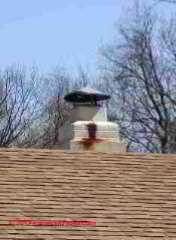
Watch out for "faux brick" metal chimneys and flues such as the factory built metal chimney shown at left. This chimney, glanced-at quickly from ground level from the other side of the house, might be mistaken for a clay tile lined brick flue with a metal rain cap.
Wrong.
This is an all-metal factory-built chimney. And inspecting from the opposite side of the home one can observe rust stains that raise the concern for a rust-perforated, damaged chimney structure, wall, or flue.
Looking closely at the bottom left of the chimney cap you can see a spot of daylight (red arrow) - this chimney cap has rusted away, risking damage to the flue and to the heating appliance.
Rust Damaged Chimney Turbine Vent or Turbulator Vent Cap
This chimney is capped by a turbine vent or turbulator chimney cap intended to improve chimney draft. In the presence of wind the spinning cap can increase chimney draft but its performance would thus be inconsistent.
We're not sure that a turbine vent provides reliable rain protection nor that this was a proper application for turbine vents.
[Research in process].
You will note that the installation is rust damaged as well.
Happily this chimney is no longer in use, so in this particular case the turbine vent and its rust are only a cosmetic issue - unless someone attempts to return the chimney and flue to service.
Squashed or Non-Listed Chimney Rain Cap Hazards: inadequate exhaust openings are unsafe
This chimney is capped by having inserted a short length of metal flue with a riveted rain cap attached. The whole assembly slides down into the flue, blocking adequate flow of exhaust gases from the gas fired heater being vented.
We suspect that this little rain cap at above left is not listed for this application and that the chimney is unsafe.
Our measuring tape is also indicating the distance to the nearest roof surface - the chimney also lacked adequate height above the nearest roof surface.
Above the round metal chimney rain cover seems to be so squashed-down as to nearly block the venting of that flue, perhaps explaining the stains and heat-damaged sealant around the flue (red and yellow arrows).
See CHIMNEY RAIN CAP OPENING SIZE
...
Reader Comments, Questions & Answers About The Article Above
Below you will find questions and answers previously posted on this page at its page bottom reader comment box.
Reader Q&A - also see RECOMMENDED ARTICLES & FAQs
On 2018-05-17 - by (mod) -
Thank you so much for the nice comment, Ace. We work hard to provide authoritative and un-biased information so I am especially grateful when you, as my reader, report having found our work useful.
We also welcome criticism and content suggestions - working together makes us smarter - or at least seem smarter.
- Ed.
On 2018-05-17 by ace
Wonderful site for informing (us), me about how and what will correct my chimney situation. Thanks.
On 2017-04-04 - by (mod) -
Really Greg?
The only comments that get blocked by our Comments Software are comments that contain what the software thinks is a url, a link, advertisements, or bad language.
Take note of our reply to your comment posted two hours ago, thanking you and noting that we'd keep the comment in the article when it's updated.
Where's the misunderstanding?
InspectAPedia is an independent publisher of building, environmental, and forensic inspection, diagnosis, and repair information provided free to the public - we have no business nor financial connection with any manufacturer or service provider discussed at our website. We do not sell products nor services.
We are dedicated to making our information as accurate, complete, useful, and unbiased as possible: we very much welcome critique, questions, or content suggestions for our web articles. Working together and exchanging information makes us better informed than any individual can be working alone.
Website content contributors whether it is just a small correction or an in-depth article series (which of course invites more search engine attention), are, if they choose, cited, quoted, and linked-to from the appropriate additional web pages and articles - which benefits us both. Those who wish to remain anonymous can also do so.
On 2017-04-04 by Greg Hahnel
Hi, I understand why you don't post many of my comments, I get it. A little about me, I am a journeyman red seal plumber/gas fitter also heating and sheet metal tech and have been in this line of work for over 25 years in Calgary Alberta Canada. So I am very familiar with a wide variety plumbing, heating and venting products ,codes and methods.
Especially products from the past no longer in use. I can recognize and place a manufacturers name and approximate date on many (retro) venting products, where many other professionals can't (or don't remember) I'm not trying to prove anyone wrong, just like to point out things that are sometimes missed that might explain why a certain condition or problem has occurred. ps. I'm an un official b vent expert. lol!
On 2017-04-04 - by (mod) -
Greg, thank you for the interesting and helpful comments. I'll keep these in the article when it's updated.
Daniel
Hound
"Sweating" to be more technical, is of course not sweating- the moisture or liquid you see on your chimney cap is condensed moisture from the flue gases being exhausted. Hot gas holds more liquid. It hits the cool chimney sides and cap as it rises up the flue. Those surfaces cool the gas, squeezing out moisture that condenses on the chimney and cap surfaces.
It may be that your chimney is too short since you point out that you're using dry wood and building hot fires. Or there could be draft problems such as a chimney leak. I'd ask a chimney sweep, certified by the National Chimney Sweeps Guild (if you are in the U.S.) for a safety inspection and some advice.
On 2017-04-03 by Greg Hahnel
I noticed the two photos of the chimney connected to the oil fired boiler, that is not a stainless chimney cap corroding.
That is an aluminum Selkirk rv-rt-6 b vent cap, deteriorating from excessive heat. I hope the whole venting system isn't b vent! Likely only the rain cap was replaced by an individual that acquired the wrong cap for the application. B vent is for natural gas and propane only, oil will burn a lot hotter. Especially a commercial application boiler, and would eventually damage b vent and its components.
The cap in the photo has kind of an iridescent color like stainless I agree , but over heated aluminum caps will do just that. I have seen where guys threw a b vent cap on a fire place chimney and the same thing has happened to the cap.
These caps are not welded, they are held together with rivets, the holes indicate hottest spots of the cap where the aluminum has literally began to melt.
This is a great example of the importance of hiring professional licensed trades to install or repair any fuel burning venting system. Cheers:)
On 2016-11-20 by HoundDog
I have tryed a couple types of chimney caps. Problem is they seem to sweat and drip rusty stain drips .and when wind gets a blowin my white vinyl siding gets splattered by the drip mix of creosote & rusty water drips, Other times would get clogged seams like just a few burns ?
I do use good seasoned oak and make sure she burns hot ,use creosote sticks and powder , I keep agood eye on chimney clean it once a month weather it needs it or not. But still can't stop these capsfrom sweating ? Any one got input wood love to hear from ya. . NJ HoundDog
On 2015-12-04 - by (mod) -
Linda:
If the rain cap design and opening dimensions restrict air flow then the system risks improper draft, improper or unsafe functioning.
The un-used flue can be closed off at the chimney top to keep out pests and water;
The in-use flue needs to have a UL-listed (presuming you're in the U.S., or CSA listed in Canada) rain cap properly sized for the flue that it protects.
There is confusion about terms chimney crown, chimney cap, and rain cap; I hope we've sorted that out here.
Don't pay before you know your system is properly protected and safe.
Use the page bottom CONTACT link if you want to send me some sharp photos of the chimney top and rain cap.
On 2015-12-04 by Linda Kager
Hi.
I was trying to buy a Chimney Cap (“rain hat”) for my masonry brick multi-flue residential chimney, and was working with a company. What they were selling me was a Chimney Cap. I felt my chimney was perhaps somewhat larger than their standard size, and offered to pay for the larger-sized cap. What they DID do was put on one single-flue cap.
My house is nearing 100. The actual chimney is in reasonable shape. The two flues = one for oil furnace, one for non-used fireplace [converted to electric, with air-bladder internal damper; Seattle has asked us not to use fireplaces anymore for air quality].
All I wanted to do was to get a “rain hat” to preserve the internal integrity of the unit.
We have talked past each other, the Company and I, with the company trying to buffalo me in to believing what they did for a Chimney Cap is right and proper.
Am I off the mark here?
(I think what they have done is even worse than nothing, changing the flow dynamics to increase even more water to the other flue. I want the WHOLE chimney covered, and am willing to pay the difference.)
I, um, think I am being a bit bullied here, and am simply seeking verification of what I think is right and proper.
I would leave your name out of it!
P.S. I have read much on your site; perhaps I was misunderstanding what I thought I was buying? That said, I still believe I should have been informed in a meaningful way from a professional. I do know I want a "Rain Cover" and believed the Company and I had arrived at that place. THANK YOU FOR THIS FABULOUS SITE.
Thank you for taking the time to respond (I hope).
Question:
(Dec 3, 2014) Tony said:
We installed a triple walled metal chimney 12'run of pipe straight up from the top of our woodstove to 3' above the roof line. We burn our stove almost constantly at 250F-400F.We don't see any creosote buildup when inspecting and cleaning the chimney, but are plagued by soot collection in the top 3'-5' of the chimney.
There is no chase surrounding the exposed section of the chimney, would an insulated chase eliminate this problem? Or are there other solutions? I'm getting too old to keep climbing up on the roof all winter.
Reply:
Tony I'm not confident I can safely diagnose and recommend for this concern. Light soot from a woodstove at a chimney top may be ok but if soot blocks the cap, screen or flue there are indeed safety hazards. I agree that depending on the chimney height, enclosing the flue increases its temperature - but in wood burning I'm not sure what that does to soot at the cap.
I would feel that you are safest getting onsite advice from a certified chimney sweep. Do keep us posted.
Question:
(Feb 2, 2015) Eva said:
Do you need licence to produce Chimney caps in nyc?
Reply:
I'm not sure Eva, if you need a special license to produce chimney caps but selling them would be another question: certainly you'd need to get your chimney caps listed by UL or another accepted authority before they'd be code-approved and thus legal to install.
Question:
30 March 2015 chris said:
what is the minimum clearance between the top of the flue liner and the bottom of the chimney cap
Reply:
Chris this question was answered in a reply to ANON - thanks for asking. That discussion can now be found at
CHIMNEY CAP CLEARANCE & OPENING DIMENSIONS
...
Continue reading at CHIMNEY RAIN CAP / RAIN COVER DIY or select a topic from the closely-related articles below, or see the complete ARTICLE INDEX.
Or see these
Recommended Articles
- CHIMNEY CAP / CROWN CONSTRUCTION
- CHIMNEY CAP & CROWN DEFINITIONS
- CHIMNEY "CAP" CROWN / TOP SEAL INSPECTION
- CHIMNEY RAIN CAP / RAIN COVER INSPECTION
- CHIMNEY RAIN CAP / RAIN COVER DIY
- CHIMNEY RAIN CAP VENT OPENING SIZE
- CHIMNEY POTS & DECORATIVE TOPS
- CHIMNEY SHROUDS
- CHIMNEY STAINS & LEAKS
- CHIMNEY TOP MASONRY DAMAGE
Suggested citation for this web page
CHIMNEY RAIN CAP / RAIN COVER INSPECTION at InspectApedia.com - online encyclopedia of building & environmental inspection, testing, diagnosis, repair, & problem prevention advice.
Or see this
INDEX to RELATED ARTICLES: ARTICLE INDEX to CHIMNEYS & FLUES
Or use the SEARCH BOX found below to Ask a Question or Search InspectApedia
Ask a Question or Search InspectApedia
Try the search box just below, or if you prefer, post a question or comment in the Comments box below and we will respond promptly.
Search the InspectApedia website
Note: appearance of your Comment below may be delayed: if your comment contains an image, photograph, web link, or text that looks to the software as if it might be a web link, your posting will appear after it has been approved by a moderator. Apologies for the delay.
Only one image can be added per comment but you can post as many comments, and therefore images, as you like.
You will not receive a notification when a response to your question has been posted.
Please bookmark this page to make it easy for you to check back for our response.
IF above you see "Comment Form is loading comments..." then COMMENT BOX - countable.ca / bawkbox.com IS NOT WORKING.
In any case you are welcome to send an email directly to us at InspectApedia.com at editor@inspectApedia.com
We'll reply to you directly. Please help us help you by noting, in your email, the URL of the InspectApedia page where you wanted to comment.
Citations & References
In addition to any citations in the article above, a full list is available on request.
- [1] ...
- [2] ...
- [3] Wood Heating Alliance, "BUILDING INSPECTOR'S CHECKLIST FOR FACTORY BUILT FIREPLACES [PDF] ", appearing in Baird, David J., C.B.O., "Factory-built Chimney Chase Fires: A case for More Detailed Inspection", Building Standards, March-April 1991, pp. 14-17. Note: The Fireplace Institute (FI) and the Wood Energy Institute (WEI) united to form the Wood Heating Alliance in 1980. The name was then changed again in 1983 to the Hearth Products Association (HPA) a non-profit organization, in order to better reflect the diversity and range of products and services within the industry. The name was changed once more to, Hearth Patio and Barbecue Association (HPBA) in 2001. Pacific HPBA, 2304 Huntington Dr., Suite 218, San Marino, CA 91108
(626) 237-1200 or (888) 332-2472
Fax: (626) 237-0721- info@hpbapacific.org, Website: http://hpbapacific.org/
Fireplace Safety Tips - Barbecue Safety Tips from the HPBA - see http://hpbapacific.org/pdfs/safetytips.pdf - [4] Baird, David J., C.B.O., "Factory-built Chimney Chase Fires: A case for More Detailed Inspection", Building Standards, March-April 1991, pp. 14-17.
- [5]
 Stephen Werner, General Manager, Chimney King LLC., P.O. Box 8, Gurnee, IL 60031, Tel: (847) 244-8860, Email: steve@chimneyking.com, Website: www.chimneyking.com . Mr. Werner is also a licensed home inspector serving clients in Wisconsin. Chimney King sells their products through a network of fireplace dealers, chimney sweeps, roofers and builders. Each decorative shroud is custom built because no two chimney/chase are alike.
Stephen Werner, General Manager, Chimney King LLC., P.O. Box 8, Gurnee, IL 60031, Tel: (847) 244-8860, Email: steve@chimneyking.com, Website: www.chimneyking.com . Mr. Werner is also a licensed home inspector serving clients in Wisconsin. Chimney King sells their products through a network of fireplace dealers, chimney sweeps, roofers and builders. Each decorative shroud is custom built because no two chimney/chase are alike. - Stephen Werner
General Manager
Chimney King, op cit, personal communication 3/26/2013 w/attachments:
- CHIMNEY KING INSTALLATION INSTRUCTIONS FOR CHIMNEY CROWN, [PDF]
- Purdie, Roger K., "CHIMNEY FIRE SAFETY BULLETIN", Vista Fire Protection District, 2001, report of house fire related to the home's metal chimney. Contains advice for chimney * fire safety & sketches of approved and not-code-approved metal chimney tops, caps & crowns. [PDF]
- See also CHIMNEY SHROUD FIRE - technical article contribution by Mr. Werner
- [6] Residential Masonry Fireplace and Chimney Handbook, James E. Amrhein, S.E., MIA, Masonry Institute of America, 2d. Ed., 1995, ISBN 0-940116-29-4. The MIA is in Los Angeles, CA 213-388-0472. This manual reflects the 1994 Uniform Building Code, Energy Conservation Requirements of California, and the U.S. Department of Housing and Urban Development - HUD. The complete UBC is available from the International Conference of Building Officials (ICBO), Whittier CA 310-699-0541.
- [7] NFPA 211 - Standards for Chimneys & Fireplaces, NFPA 211: Standard for Chimneys, Fireplaces, Vents, and Solid Fuel-Burning Appliances, 2006 Edition (older editions and standards are found at the same bookstore)
- [8] NFPA 211 - Standards for Chimneys & Fireplaces, NFPA 211: Standard for Chimneys, Fireplaces, Vents, and Solid Fuel-Burning Appliances, 2006 Edition (older editions and standards are found at the same bookstore), NFPA #211-3.1 1988 -
Specific to chimneys, fireplaces, vents and solid fuel burning appliances.
- NFPA 211 - 3-1.10 - Relining guide for chimneys
- NFPA 211 - 3-2 - Construction of Masonry Chimneys
- NFPA 211 - 3-3 - Termination Height for chimneys
- NFPA 211 - 3-4 - Clearance from Combustible Material
- NFPA 54 - 7-1 - Venting of Equipment into chimneys
- [9] NFPA # 54-7.1 1992 - Specific to venting of equipment with fan-assisted combustion systems.
- [10] GAMA - Gas Appliance Manufacturers' Association has prepared venting tables for Category I draft hood equipped central furnaces as well as fan-assisted combustion system central furnaces.
- [11] National Fuel Gas Code, an American National Standard, 4th ed. 1988 (newer edition is available) Secretariats, American Gas Association (AGA), 1515 Wilson Blvd., Arlington VA22209, and National Fire Protection Association (NFPA), Batterymarch Park, Quincy MA 02269. ANSI Z223.1-1988 - NFPA 54-1988. WARNING: be sure to check clearances and other safety guidelines in the latest edition of these standards.
- [12] Fire Inspector Guidebook, A Correlation of Fire Safety Requirements Contained in the 1987 BOCA National Codes, (newer edition available), Building Officials and Code Administrators International, Inc. (BOCA), Country Club HIlls, IL 60478 312-799-2300 4th ed. Note: this document is reissued every four years. Be sure to obtain the latest edition.
- [13] Uniform Mechanical Code - UMC 1991, Sec 913 (a.) Masonry Chimneys, refers to Chapters 23, 29, and 37 of the Building Code.
- [14] New York 1984 Uniform Fire Prevention and Building Code, Article 10, Heating, Ventilating, and Air Conditioning Requirements
- New York 1979 Uniform Fire Prevention & Building Code, The "requirement" for 8" of solid masonry OR for use of a flue liner was listed in the One and Two Family Dwelling Code for New York, in 1979, in Chapter 9, Chimneys and Fireplaces, New York 1979 Building and Fire Prevention Code:
- [15] "Top Ten Chimney (and related) Problems Encountered by One Chimney Sweep," Hudson Valley ASHI education seminar, 3 January 2000, contributed by Bob Hansen, ASHI
- [35] "Building Codes that Regulate Decorative Chimney Shrouds", provided by Stephen Werner [5], [copy on file as Chimney_Decorative_Shroud_Regs.pdf] cites:
- International Mechanical Code IMC (2000), M74-98 806.6, ratified 9.98, model building code for the United States,
806.6 Decorative Shrouds. Decorative shrouds shall not be installed at the termination of factory-built chimneys, except where such shrouds are listed and labeled for use with the specific factory-built chimney system and are installed in accordance with section 304.1. Reason: Decorative shrouds have been the cause of roof and chase fires - International Residential Code (IRC) (2000), R1002.2 ratified 9/99, 1000.2 Decorative Shrouds. Decorative shrouds shall not be installed at the termination of factory-built chimneys, except where such shrouds are listed and labeled for use with the specific factory-built chimney system and are installed in accordance with the manufacturers installation instructions. Reason: Decorative shrouds often allow for the creation of temperatures in excess of those permitted in UL 103 and UL 127. Decorative shrouds have been the cause of chase top fires ...
- International Fire Code (IFC) (2000), IFC 603.6.3, 603.6.3 Decorative Shrouds. Decorative shrouds installed at the termination of factory-built chimneys shall be removed, except where such shrouds are listed and labeled for use with the specific factory-built chimney system and are installed in accordance with the manufacturers installation instructions. Reason: Decorative shrouds have been the cause of dozens of chase fires. As a non-listed part to a listed assembly, their use should not have been allowed in the first place.
- International Mechanical Code IMC (2000), M74-98 806.6, ratified 9.98, model building code for the United States,
- [36] International Residential Code IRC R100.11 - Fireplace Clearance:
International Residential Code was recently amended:-
R1001.11 Fireplace clearance. Combustible material shall have a clearance of not less than 2 inches (51 mm) from the front faces and sides of masonry fireplaces and not less than 4 inches (102 mm) from the back faces of masonry fireplaces. The air space shall not be filled, except to provide fire blocking in accordance with Section R1003.12.
Exceptions:1. Masonry fireplaces listed and labeled for use in contact with combustibles in accordance with UL 127, and installed in accordance with the manufacturer's installation instructions, are permitted to have combustible material in contact with their exterior surfaces.
2. Combustible materials, including framing, wood siding, flooring and trim, shall be permitted to abut the sides and hearth extensions, but not the backs, of masonry fireplaces, in accordance with FIGURE R1003.12, provided such combustible materials are a minimum of 12 inches (306 mm) from the inside surface of the nearest firebox lining.
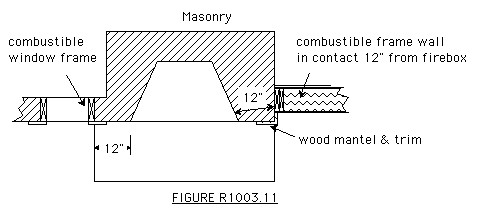
3. Exposed combustible mantels or trim may be placed directly on the masonry fireplace front surrounding the fireplace opening provided such combustible materials shall not be placed within 6 inches (153 mm) of a fireplace opening. Combustible material within 12 inches (305 mm) of the fireplace opening shall not project more than 1/8 inch (3.2 mm) for each 1-inch (25 mm) distance from such opening.
- Arlene Puentes [Website: www.octoberhome.com ] , an ASHI member and a licensed home inspector in Kingston, NY, and has served on ASHI national committees as well as HVASHI Chapter President. Ms. Puentes can be contacted at ap@octoberhome.com
- In addition to citations & references found in this article, see the research citations given at the end of the related articles found at our suggested
CONTINUE READING or RECOMMENDED ARTICLES.
- Carson, Dunlop & Associates Ltd., 120 Carlton Street Suite 407, Toronto ON M5A 4K2. Tel: (416) 964-9415 1-800-268-7070 Email: info@carsondunlop.com. Alan Carson is a past president of ASHI, the American Society of Home Inspectors.
Thanks to Alan Carson and Bob Dunlop, for permission for InspectAPedia to use text excerpts from The HOME REFERENCE BOOK - the Encyclopedia of Homes and to use illustrations from The ILLUSTRATED HOME .
Carson Dunlop Associates provides extensive home inspection education and report writing material. In gratitude we provide links to tsome Carson Dunlop Associates products and services.



